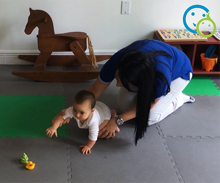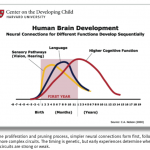 Try this test: ask 5 parents when their children took their first steps. My guess is that 4 of them will be able to tell you the exact month it happened. Do the same with crawling – I’m guessing maybe 1 or 2 will recall. Walking is important (and fun to get on video), but crawling is actually a far more important milestone, as far as creating long-term benefits. Obviously we all need to learn to walk, but learning to crawl is a critical first step.
Try this test: ask 5 parents when their children took their first steps. My guess is that 4 of them will be able to tell you the exact month it happened. Do the same with crawling – I’m guessing maybe 1 or 2 will recall. Walking is important (and fun to get on video), but crawling is actually a far more important milestone, as far as creating long-term benefits. Obviously we all need to learn to walk, but learning to crawl is a critical first step.
Highlights:
|
As a parent of an almost walker (our little one turns 1 next week), I am doing the opposite of what most parents do. I am trying to delay walking a bit longer, hoping my son keeps crawling for at least another month or two. Keeping him on his belly a bit longer has a ton of benefits. More are being discovered all the time, but here are 5 of the most important:
- Strengthens trunk, shoulders, arm and hand muscles. Crawling is incredibly hard work (try it for yourself – it’s not easy!) All of the core muscles work together to maintain an upright position, while the arms and shoulders help propel the baby forward. There are few things that a baby can do to work all of those muscles more efficiently. These months of crawling form the foundation for his or her future core strength. Once your child is vertical and walking, this natural workout for core and upper body muscles will stop.
- Helps develop binocular vision. Switching between looking down and looking ahead forces the baby’s eyes to continuously focus at different distances. This skill is what your child will use to easily switch between notebook and blackboard when taking notes at school.
- Improves hand-eye coordination. Crawling will allow a baby to first identify a “target” with his eyes and then use his hands while crawling to guide his body to “acquire the target.”
- Cross communication between both sides of the brain. Bi-lateral movement strengthens both the left and right side of the brain, enhancing communication across the 2 sides. This will help your baby do things like pass a ball from side to side or know how to move both the left and right leg in succession in order to walk or run.
- Helps integrate the Symmetric Tonic Neck Reflex (STNR). This reflex allows us to operate our upper and lower body independently. Children that fail to integrate the STNR are often clumsy and have poor balance & coordination, among other issues. Furthermore, there is an interesting study by Dr Miriam Bender that links the lack of integration of this reflex with learning disabilities and ADHD.
The list goes on, but just with the benefits above, you can understand why at BabySparks we are big believers in crawling. Under the Browse by Milestones section of the BabySparks app, there are 20+ activities specifically designed to help your little one master crawling.
Back







